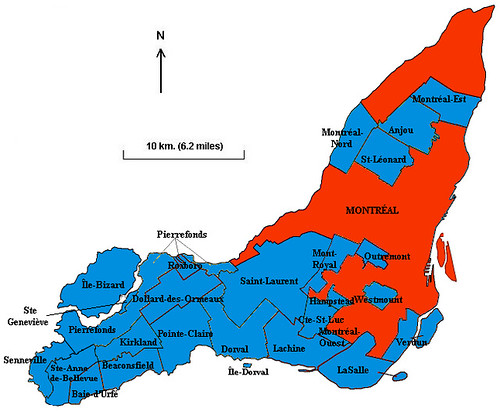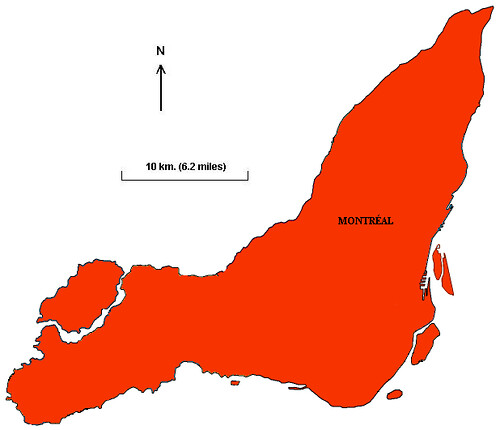
If this were 2002 rather than 2009, Louise Harel might be spending this week looking more like the photo above (she’d be smiling). Why? Well, because in 2002, the geography of Montreal was much different than it is now. Before 2002, Montreal was a much smaller city surrounded by a number of independent municipalities on all sides as can be seen on this map:

In 2002, all across Quebec, small municipalities were merged together to create large, centralised cities. In Montreal, this meant merging all the towns on the island into the city of Montreal in an attempt to create “une île, une ville”. After the merger, this is what the city of Montreal looked like:

One would think this would be a good idea, but for various reasons, many of the former towns on the island (and, indeed, across Quebec) were not happy with the reorganisation and wanted to demerge to their former separate municipalities. In 2006, referendums were held across the province and a handful of the merged municipalities were able to demerge. After the demergers, Montreal looked as it does today:

So, how would the election have turned out had the mergers and subsequent demergers never happened. To find out, I crunched some numbers. I isolated the total number of votes for the three major parties for the areas of the city that were part of pre-2002 Montreal (what are now the boroughs of Ahuntsic-Cartierville, CDN-NDG, Mercier–Hochelaga-Maisonneuve, Le Plateau-Mont-Royal, Rivière-des-Prairies–Pointe-aux-Trembles, Rosemont–La Petite-Patrie, Le Sud-Ouest, Ville-Marie, and, Villeray–Saint-Michel–Parc-Extension) and added them up. These are the results:
Gérald Tremblay – 88 854 – 34%
Louise Harel – 101 773 – 38%
Richard Bergeron – 78 138 – 30%
Note that the percentage is taken from total number of votes for those three candidates, not total number of votes cast.
As we can see, had the election only been in the original 9 boroughs, last Sunday would have been much more interesting. In the old city, all three parties were in the 30% range and all were within 4% of their closest rival. Harel would have won by a mere 4% and Bergerone would have lost by only 8%. Tremblay’s second place would have sent him to the Opposition side of City Hall.
The most interesting part of all of this is the irony of the fact that Louise Harel is the one responsible for the mergers. Back when she sat as a PQ member in the National Assembly, she served as Minister of Municipal Affairs. As an MNA, it can be argued that the most important thing she did was to table the bill that led to the municipal reorganisations across Quebec. The whole mess caused by the mergers played a large role in the ousting of her party from power in the provincial election that followed. Had she left everything well enough alone, she might be mayor today. However, had she left everything alone, she might still be in the National Assembly.
Photo via Louise Harel’s Facebook. Maps via Wikipedia.

10 comments
Chris, the actual numbers when rounded up or down to their closest integer are actually 33, 38 and 29. Not that it changes what you’re trying to say.
What a fascinating exercise, thanks Chris. Ironic indeed.
But I have no patience for the anti-merger people. One look at the pre 2002 map show just how ridiculous things were. Every one of those tiny fiefdoms were there as satellites of Montreal, benefiting from their proximity to, and association with, the city. I just with I trusted Harel more, cause she probably would have had my vote, separatist or not.
heh. You wrote “Bergerone”. Sounds Italian!
Jean-François Lisée made the same calculation. It’s cute, but of course academic.
The demerger referendums happened in June 2004, by the way. They took effect in 2006.
Ca serait quand même moin stupide de voir les villes qui sont “land-locked” dans une autre ville (voir Westmount dans Montréal par exemple) être fusionnée quand même!
Ca rendrait le jeux des fusions plus amusant :P
Thanks for the great article and before/after maps… Very helpful and indeed ironic.
Thanks for posting these maps, I wasn’t in Montreal for the whole merger/demerger thing but what a mess. The history of it is really interesting though.
We need to be setup like a modern functional city. I also (mostly) agreed with Harel on this topic, the numbers Vision Montreal supplied about boroughs and city representatives in Toronto and New York made Montreal look like a wasteful joke.
Looking at the maps it seems that the island could be split into four super-boroughs with a few extra rights extended to some areas like Westmount, TMR, or Est-Montreal to preserve their feeling that they are different from their surroundings. I guess we just need a benevolent dictator in chared to make it happen.
You also should hypothesize what would have been the results if the west-island had not been de-merged as Harel kept saying was a terrible liberal mistake.
To do that you would need to make an assumptions about how the west Island would have voted…
I think you would find that Harel would have been a massive loser in that situation. Since the W-I is so car dependent and not receptive to Projet Montreal’s message, Bergeron would have also been a big loser. Tremblay would have been re-elected in another landslide just like 2005.
Look at the results for un-de-merged boroughs – they voted heavily for Tremblay.
Projet Montreal only did well in central city boroughs.
Ironically, in voting to de-merge, anglophones reduced their political power in the city. Had the west island stayed merged, mayoral candidates would have to court the anglophone vote. Now, the small anglophone cities do not have a common voice and are demographically outweighed by Montreal in the agglomeration council.
It’s only a matter of time, the old cities/demerged cities will come back in the fold, eventually.
It makes no sense, as J. Lawlor says.
Only by being close to the power can you enable changes in your favor.
Right now the CMM has much more power over the demerged than in the old C.U.M.
I still believe that the mergers are good, they were just not well received due to haste, lack of information, lack of discussion with the mergees, no intermediate solution between 29 cities to 1 (they could have first merged into 3 or 4 bodies with the expected final merger 4-8 years later, just to smooth things out between neighbors).
In the meantime, west islanders should really look into merging with one another to create a real West Montreal.
That’s if they have any long term vision and want to regain some power. Big if…
I bet they could even attract more currently merger old cities to join them like Ile-Bizard, Pieerfonds-Roxboro, St-Laurent, etc…
Make it a one island 2 cities…
I don’t have a problem with having many different municipalities on the island. First off, this is very common all over the world and smaller cities are simply run better; more efficiently and with significantly better level of service, cleanliness and better responsive to the needs of the citizens. Indeed, smaller is more democratic. Also, West Island cities for example are suburban in character, lifestyle, and layout and would not necessarily be a cohesive match with the City of Montreal.
Also, there are a lot of sensitivities in these municipalities that cannot be ignored or scoffed at… in a political process (Quebec) where many feel like they have no voice and don’t matter, having these cities allows people to at least have some voice…
That said, I can see the island joined with but 4 or 5 boroughs. Much like New York City.